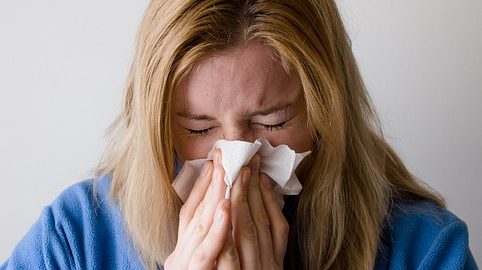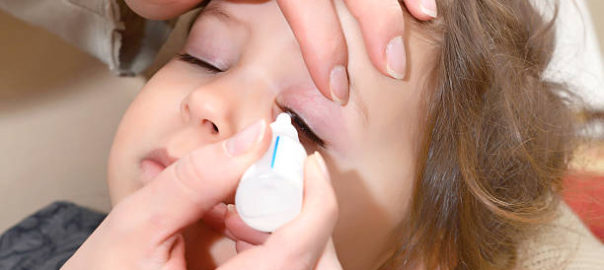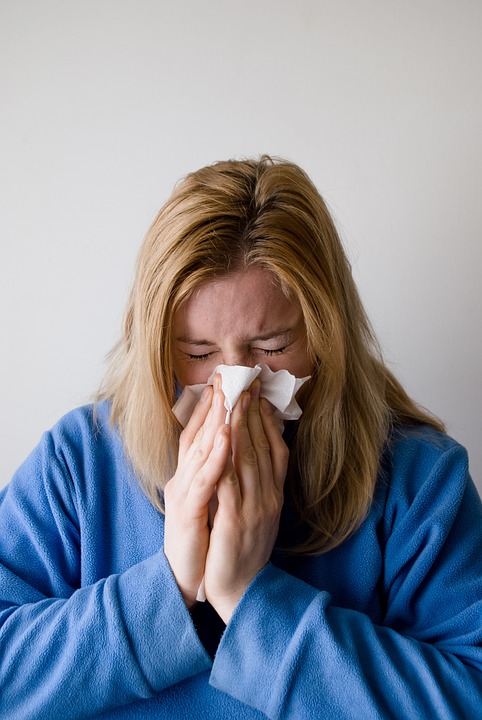Allergies

August 24, 2021. Ragweed Allergies vs Covid-19 vs Cold
What is Ragweed Allergy Season?
Though you may not realize it yet, ragweed allergy season is upon us again. Every year in mid-August the inevitable sneezing and itching takes over and makes life a whole lot more difficult for the rest of the summer and early fall. For those allergic to late summer and fall pollens, especially ragweed, this year is no exception despite how out-of-the-ordinary the rest of life has been.
Ragweed is just what it sounds like – a weed! It will grow anywhere from cracks in cement to open fields and in all kinds of weather conditions. “They are really hearty,” explains Dr. Marc Goldstein, board certified allergist at The Asthma Center. And due to increasing carbon dioxide levels and rising temperatures, we are experiencing an earlier onset of the ragweed season than usual. According to Dr. Goldstein, “the season is starting earlier, and possibly will end a little later.” Additionally, this is due in part to hot days and long hours of sunlight, which promotes ragweed growth after plants have germinated in the spring. In general, an individual ragweed plant can produce over 50 million pollen grains and ragweed pollen can remain airborne for over a 200-mile radius, which puts a whole lot of people in the line of pollen fire!
Ragweed Allergy vs COVID-19 vs Colds
The big question that crosses the mind of every allergy sufferer now during the COVID 19 pandemic is, “How do I know if I am experiencing allergy symptoms, COVID-19, or even just a cold?” In general, ragweed allergy is characterized by nasal congestion, runny nose, sneezing, and itchy eyes. COVID-19, on the other hand, brings on fatigue, fever, body aches, cough, and shortness of breath.
One of the more common symptoms that can lead to confusion between ragweed allergy, COVID-19, and the common cold is an acute loss of sense of smell which can occur in all three of these conditions. So, how can one know what is causing the smell loss? Smell loss is almost always associated with nasal congestion in those who are allergic to ragweed and often with those who have colds. However, nasal congestion is not typically associated with smell loss in those who have COVID-19. It can get confusing, but the below chart may help differentiate symptoms of allergies, COVID-19, the flu, and a common cold. Most of the time people regain their sense of smell despite the cause. However, for those whose loss of smell remains impaired, The Asthma Center has developed treatment options which have helped many people regain some or all of their sense of smell. In an interview with CBS reporter Stephanie Stahl about one such treatment, an Asthma Center patient explains, “It’s been a total life changer. I call it liquid gold.” Read the full interview here.

To learn more about COVID-19, especially for those with asthma, please read our blog COVID-19 vs Asthma.
How Long Does Ragweed Allergy Season Last?
While ragweed season may feel like an eternity for those living through these allergic symptoms, it should start to wind down by mid-fall. That may sound like a long way off, but the leaves will start changing and we will all start breathing a little easier. And if not, give us a visit at The Asthma Center and we’ll work our magic! There are many effective and safe treatments to help allergy sufferers comfortably get through the season.
To learn more about Ragweed allergies, please visit Dr. Goldstein’s article about Ragweed on the Curist website here.
More Info

June 4, 2021. Seafood, Cicadas, Dust Mites – OH MY!
As we delve farther into this cicada season, some interesting questions, observations, and research have been taking place. On the forefront is the news of the cross-relation between seafood allergies and cicada allergies. The cicada is the distant cousin of the seafood family and shares cross-reacting proteins. As a result, the FDA is advising against the consumption of cicadas if you have a known seafood allergy. Yes, you read that right – people are eating cicadas this year! And things only get more complicated when we introduce dust mites into the conversation. Read on for more…
Cicadas emerge from the ground every 17 years by the billions. So, why has it become so popular to eat them this time around? The main catalyst for this trend stems from a report from the United Nations back in 2013, in which they described the ways eating bugs could improve the global food sustainability crisis. In addition, bugs like cicadas are a great gluten-free, low-fat source of protein. There are also historical roots to eating cicadas in the United States. Some Native American tribes ate insects and would certainly eat cicadas when their 17-year cycle came around. These factors amongst others have combined to create the right environment for cicada-eating popularity in 2021.
While this might sound like a great sales-pitch to fry up some cicadas, the Food and Agriculture Organization of the U.N. later reported that the allergenic risks of eating insects need more investigative research before we all dig in. And this is what prompted the connection being made between cicadas and seafood, like shrimp and lobster. Both belong to the arthropod family, causing some to even nickname cicadas “tree shrimp”. Simply put, those who are allergic to seafood, such as shrimp, are likely to have an allergic reaction to cicadas and should avoid consuming both.
If that wasn’t bizarre enough, there is a third factor at play involving dust mites. As explained in the 2018 volume of Molecular Immunology, “Various insect allergens have been identified including tropomyosin and arginine kinase, which are both pan-allergens known for their cross-reactivity with homologous proteins in crustaceans and house dust mite.” Essentially, if someone is allergic to dust mites there is concern that they are also allergic to cicadas due to the allergenic connection between cicadas and crustaceans. It should also be noted that there is a close relation between cicadas, cockroaches, crickets, and other insects. So, those who have a known allergy to these insects should steer clear of cicadas as well.
This cross-reactivity is not well known even among allergists, but is incredibly important for allergists to be aware of and to consistently learn more about these as cultural trends shift and develop. And while many people in the U.S. might turn their noses up at the idea of eating cicadas, it is still vital for us to understand the connections that exist between allergens. In summary, while cicadas might put a crunch in your cookie it may be best to stick with chocolate chips!
More Info
May 11, 2021. Itchy Eye Relief without the Preservatives
Many springtime allergy sufferers rely on oral antihistamines to address a range of allergy symptoms. And according to many patients, one of the more annoying issues which is not always resolved is itchy eyes. Dr. Goldstein, Director of The Asthma Center, explains, “Spring pollen season is definitely the worst time of year for ocular allergies, and many spring hayfever sufferers are experiencing intense eye allergy symptoms.” Outside of oral antihistamines there are antihistamine eye drops, which work quicker but often sting on initial application. This can make an already irritating situation even more maddening.
Bausch & Lomb seem to have found a solution. They are now manufacturing a new over the counter eye drop – Alaway Preservative Free. Obviously, these drops do not contain any preservatives and this can be a game changer for many. Preservatives can cause additional irritation to puffy, sore eyes. This can be a problem especially for children. Not only are eye drops difficult to administer to children in general, but a painful experience can make it even harder in the future. Preservative free eye drops can alleviate this issue. It is important to note that Alaway drops are safe to use with anyone over the age of 3. In addition, they are fast acting – working within a few minutes – and last up to 12 hours. Not only do the drops address itchiness, they also work to reduce allergic inflammation.
Outside of oral and eye drop antihistamines, it is important to know some basic ways to reduce allergy itchiness:
- Wear sunglasses or glasses outdoors to limit exposure of pollen to your eyes.
- Avoid wearing contact lenses, or switch to daily disposable contacts to avoid allergens building up on the lenses.
- Wash your hands and face frequently, including eyebrows.
- Change your pillowcase often.
- Visit our allergists at The Asthma Center to determine the cause of your allergies. It may also be necessary to get prescription eye drops or begin allergen immunotherapy (shots).
If you think that Alaway Preservative Free eye drops could be a fitting solution for your spring allergies, feel free to ask one of our physicians at your next visit.
More Info










